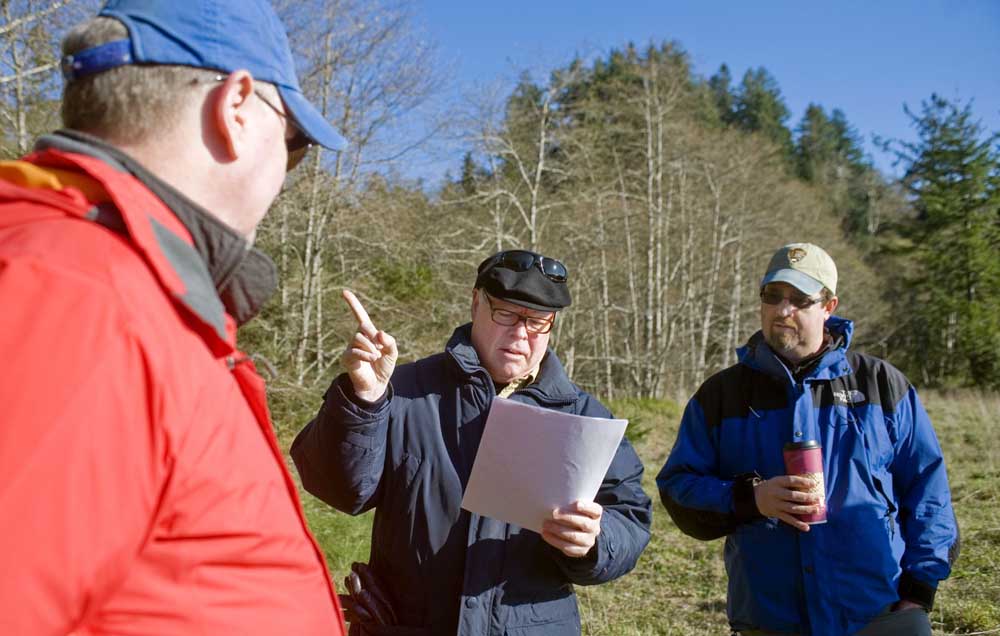‘Our situation is dangerous’
Published 4:07 am Monday, November 17, 2014

- Steve Forrester, middle, publisher of The Daily Astorian, points up toward Cliff Point while reading aloud from the journal of Capt. William Clark to Matt Winters, editor of the Chinook Observer, left, and Scott Tucker, superintendent of Lewis and Clark National Historical Park.
DISMAL NITCH, Wash. — Had the Lewis and Clark expedition encountered clear skies similar to this past week, they may have had a more peaceful time when they reached the lower Columbia River.
Instead, the Corps of Discovery barely survived their stay in mid-November 1805 against the cliffs of what is now known as Dismal Nitch, the description Capt. William Clark used to describe the campsite in his journal.
The Corps braved torrential rains, wind, cold, thunder, lightning and hail between Nov. 10 and 15 over two centuries ago.
“Our situation is dangerous,” Clark wrote Nov. 12, 1805. “We took the advantage of a low tide and moved our camp around a point to a small wet bottom at the mouth of a Brook, which we had not observed when we came to this cove.”
Historian Jim Sayce, the Washington State Historical Society’s liaison to the Lewis and Clark National Historical Park, said it is hard to imagine how the Corps survived on the isolated land that is now near Washington Highway 401 on the north side of the river.
“They talk about these brief periods when they can dry their bedding. I cannot imagine living that way day after day,” Sayce said. “They were wearing cotton and leather, the two worst possible (fabrics).”
In what has become an annual gathering, Sayce along with Scott Tucker, park superintendent at Lewis and Clark National Historical Park, Steve Forrester, publisher of The Daily Astorian, Matt Winters, editor of the Chinook Observer and Alex Pajunas, photographer for The Daily Astorian met Friday near where Sayce believes was the Corps’ Dismal Nitch campsite.
Standing near calm shores and under sunny skies, the group took turns Friday reading from the Lewis and Clark journal entries penned during the Corps’ five days at the Dismal Nitch.
“The best way to understand the journals is to read the exact words,” Sayce said.
The frantic language written in the journals did not match the tranquil atmosphere Friday.
“Rained all the last night without intermission and this morning. Wind blows very hard but our situation is such that we cannot tell from what point it comes,” Clark wrote on Nov. 14, 1805.
Sayce believes the Corps camped in Hungry Harbor, east of the Washington State Department of Transportation’s Dismal Nitch Rest Area.
Sayce led the group Friday along the terrain and creeks around Hungry Harbor. He noted how the landscape has been altered by the construction of Highway 401 and the added fill dirt along the roadway.
“If you don’t have a highway here and no bridge, this is just an isolated, lonely outpost on the north shore,” Sayce said.
Sayce is one of two modern historians studying the history of the Dismal Nitch.
Historian Rex Ziak of Naselle, Wash., puts the campsite closer to Point Ellice, near the Dismal Nitch Rest Area, which was established in 2004.
Because the journals are written vaguely with fragmented sentences, the exact spot of the Dismal Nitch is still being debated between the historians.
Tucker said Lewis and Clark National Historical Park has not officially endorsed either theory about the Dismal Nitch location, although it is marked at the rest area near Point Ellice.
Rather, Tucker said, the park is interested in fostering the discussion.
“The National Park Service is not in the business of declaring historical fact from individual research, rather we are here it interpret and preserve the resources for future generations,” Tucker said. “In the interpretation, we provide as many points of view as possible to help create the complete story and provide visitors the opportunity to determine for themselves how the story unfolds.”

